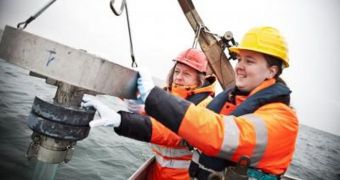Investigators at the Aarhus University, in Denmark, say that they were recently able to conduct a series of studies on the level of activity microorganisms living deep under the seabed are engaged in. This study may help explain some mysteries related to Earth's complex carbon cycle.
Details of the research effort – which involved an international collaboration of investigators – were published in the latest issue of the top scientific journal Nature. The work was led by AU Department of Bioscience microbiologist Bente Lomstein.
Colleagues from the Center for Geomicrobiology at the Danish National Research Foundation were also a part of the work. The team used the fact that bacteria living deep under the ocean floor are the only organisms that produce D-amino acids as a starting point for their investigation.
Their primary method of conducting the research was to boil the recovered mud samples in acid. This allowed them to discover the chemical signature of D-amino acids in the samples, Astrobiology Magazine reports.
“Seventy per cent of our planet is covered by ocean, which means that seventy per cent of the planet is made up of seabed consisting of sediments that store old organic matter,” Lomstein explains.
He adds that certain areas house deposits that are at least 100 meters (340 feet) thick, which means that anywhere between 10 and 30 percent of the entire biomass living on this planet lies in oceanic mud.
“The bacteria in the seabed convert the carbon of organic matter to CO2, and if we add it all up, the metabolism down there plays a crucial role in the global carbon cycle, even if it happens very slowly,” he goes on to say.
Understanding the way Earth recycles carbon is extremely important for studies conducted on global warming and climate change. They may help reveal just how much carbon dioxide the planet can handle before its stress thresholds are exceeded, and changes we make become irreversible.
But the new investigation could also be used for a wide array of other applications, such as for example searching for previously-unknown lifeforms in other hostile environments.
“Our knowledge can be used in ancient environments with extremely low biological activity, such as permafrost soil. The method is particularly useful for detecting life in the most inactive environments,” Lomstein concludes.

 14 DAY TRIAL //
14 DAY TRIAL //